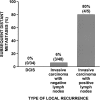The impact of adding radiation treatment after breast conservation surgery for ductal carcinoma in situ of the breast
- PMID: 20956827
- PMCID: PMC5161063
- DOI: 10.1093/jncimonographs/lgq020
The impact of adding radiation treatment after breast conservation surgery for ductal carcinoma in situ of the breast
Abstract
Ductal carcinoma in situ (DCIS; intraductal carcinoma) is most commonly detected as suspicious microcalcifications on routine screening mammography in an asymptomatic woman. As most women with newly diagnosed DCIS are eligible for breast conservation treatment, a major decision for most women is whether or not to add radiation treatment after surgical excision (lumpectomy). In four prospective randomized clinical trials, the addition of radiation treatment after lumpectomy reduced the risk of local recurrence by approximately 50%, both for overall local recurrence and for the subset of invasive local recurrence. Nonetheless, efforts have continued to attempt to identify a subset of patients with favorable DCIS who are at sufficiently low risk of local recurrence that omitting radiation treatment is reasonable. Prospective and retrospective studies have demonstrated excellent long-term outcomes at 10 and 15 years after breast conservation treatment with radiation. Careful follow-up, including yearly surveillance mammography, after initial breast conservation treatment with radiation is warranted for the early detection of potentially salvageable local and local-regional recurrences.
Figures






Similar articles
-
Long-term outcomes of invasive ipsilateral breast tumor recurrences after lumpectomy in NSABP B-17 and B-24 randomized clinical trials for DCIS.J Natl Cancer Inst. 2011 Mar 16;103(6):478-88. doi: 10.1093/jnci/djr027. Epub 2011 Mar 11. J Natl Cancer Inst. 2011. PMID: 21398619 Free PMC article. Clinical Trial.
-
The impact of surgery, radiation, and systemic treatment on outcomes in patients with ductal carcinoma in situ.J Natl Cancer Inst Monogr. 2010;2010(41):130-3. doi: 10.1093/jncimonographs/lgq022. J Natl Cancer Inst Monogr. 2010. PMID: 20956816 Free PMC article. Review.
-
The impact of systemic therapy following ductal carcinoma in situ.J Natl Cancer Inst Monogr. 2010;2010(41):200-3. doi: 10.1093/jncimonographs/lgq021. J Natl Cancer Inst Monogr. 2010. PMID: 20956830 Free PMC article. Review.
-
Overview of the randomized trials of radiotherapy in ductal carcinoma in situ of the breast.J Natl Cancer Inst Monogr. 2010;2010(41):162-77. doi: 10.1093/jncimonographs/lgq039. J Natl Cancer Inst Monogr. 2010. PMID: 20956824 Free PMC article. Review.
-
Salvage treatment for local recurrence after breast-conserving surgery and radiation as initial treatment for mammographically detected ductal carcinoma in situ of the breast.Cancer. 2001 Mar 15;91(6):1090-7. Cancer. 2001. PMID: 11267953
Cited by
-
Adjuvant tamoxifen reduces subsequent breast cancer in women with estrogen receptor-positive ductal carcinoma in situ: a study based on NSABP protocol B-24.J Clin Oncol. 2012 Apr 20;30(12):1268-73. doi: 10.1200/JCO.2010.34.0141. Epub 2012 Mar 5. J Clin Oncol. 2012. PMID: 22393101 Free PMC article.
-
Management of Ductal Carcinoma In Situ (DCIS) of the Breast: Present Approaches and Future Directions.Curr Oncol Rep. 2019 Mar 5;21(4):33. doi: 10.1007/s11912-019-0777-3. Curr Oncol Rep. 2019. PMID: 30834994 Review.
-
A multigene expression assay to predict local recurrence risk for ductal carcinoma in situ of the breast.J Natl Cancer Inst. 2013 May 15;105(10):701-10. doi: 10.1093/jnci/djt067. Epub 2013 May 2. J Natl Cancer Inst. 2013. PMID: 23641039 Free PMC article.
-
A population-based validation study of the DCIS Score predicting recurrence risk in individuals treated by breast-conserving surgery alone.Breast Cancer Res Treat. 2015 Jul;152(2):389-98. doi: 10.1007/s10549-015-3464-6. Epub 2015 Jun 29. Breast Cancer Res Treat. 2015. PMID: 26119102 Free PMC article.
-
β1-Integrin via NF-κB signaling is essential for acquisition of invasiveness in a model of radiation treated in situ breast cancer.Breast Cancer Res. 2013;15(4):R60. doi: 10.1186/bcr3454. Breast Cancer Res. 2013. PMID: 23883667 Free PMC article.
References
-
- Fisher B, Dignam J, Wolmark N, et al. Lumpectomy and radiation therapy for the treatment of intraductal breast cancer: findings from National Surgical Adjuvant Breast and Bowel Project B-17. J Clin Oncol. 1998;16(2):441–452. - PubMed
-
- Fisher ER, Dignam J, Tan-Chiu E, et al. Pathologic findings from the National Surgical Adjuvant Breast Project (NSABP) eight-year update of Protocol B-17: intraductal carcinoma. Cancer. 1999;86(3):429–438. - PubMed
-
- Fisher B, Land S, Mamounas E, Dignam J, Fisher ER, Wolmark N. Prevention of invasive breast cancer in women with ductal carcinoma in situ: an update of the National Surgical Adjuvant Breast and Bowel Project experience. Semin Oncol. 2001;28(4):400–418. - PubMed
-
- Wapnir I, Dignam J, Julian TB, et al. Long-term outcomes after invasive breast tumor recurrence (IBTR) in women with DCIS in NSABP B-17 and B-24 [abstract 520] J Clin Oncol. 2007;25(suppl):7s.
-
- Bijker N, Meijnen P, Peterse JL, et al. Breast-conserving treatment with or without radiotherapy in ductal carcinoma-in-situ: ten-year results of European Organisation for Research and Treatment of Cancer randomized phase III trial 10853—a study by the EORTC Breast Cancer Cooperative Group and EORTC Radiotherapy Group. J Clin Oncol. 2006;24(21):3381–3387. - PubMed
Publication types
MeSH terms
Substances
LinkOut - more resources
Full Text Sources
Medical
Research Materials

